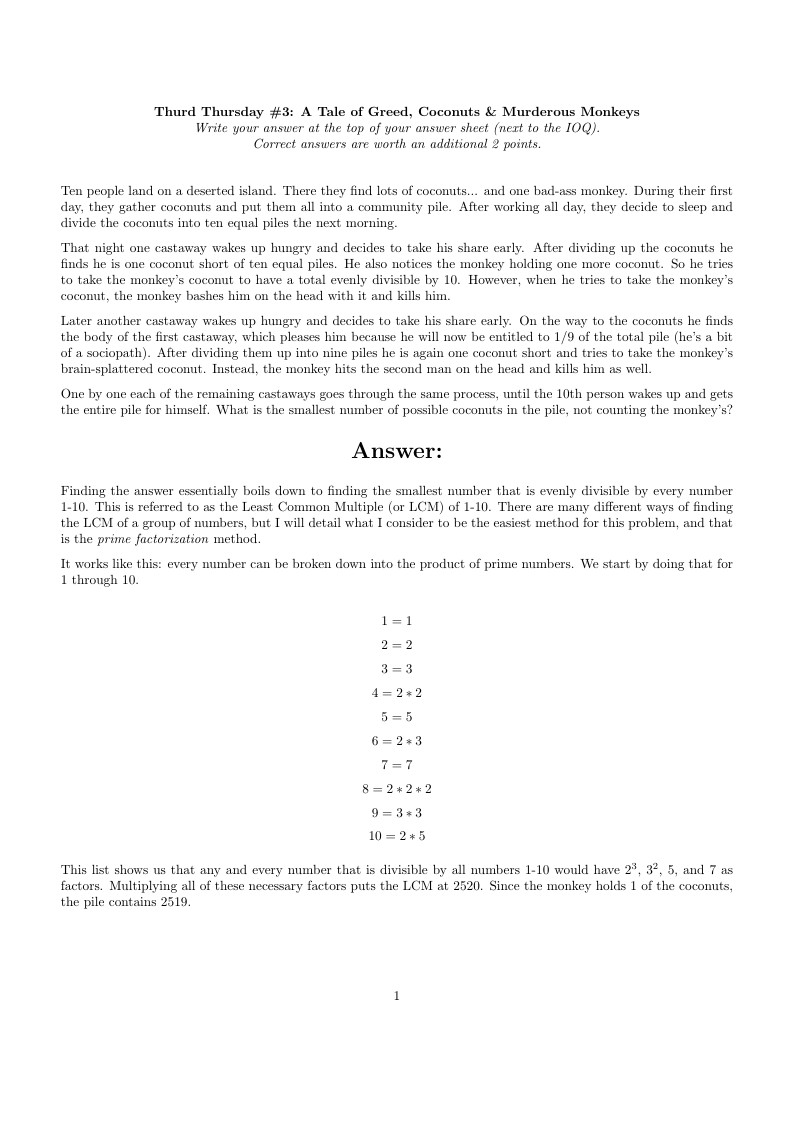
A logic/math puzzle and solution.

\documentclass[10pt]{letter}
\usepackage{amssymb}
\usepackage{url, tikz}
\usepackage{array}
\usepackage{multicol}
\usepackage[colorinlistoftodos]{todonotes}
\usepackage{ulem}
\usepackage[english]{babel}
\usepackage[a4paper,total={7in,9in}]{geometry}
\usepackage[utf8]{inputenc}
\usepackage{amsmath}
\usepackage{graphicx}
\usepackage{scrextend}
\begin{document}
\begin{center}
\textbf{Thurd Thursday \#3: A Tale of Greed, Coconuts \& Murderous Monkeys}\\
\textit{Write your answer at the top of your answer sheet (next to the IOQ).\\
Correct answers are worth an additional 2 points.}\bigskip
\end{center}
\noindent
Ten people land on a deserted island. There they find lots of coconuts... and one bad-ass monkey. During their first day, they gather coconuts and put them all into a community pile. After working all day, they decide to sleep and divide the coconuts into ten equal piles the next morning.
That night one castaway wakes up hungry and decides to take his share early. After dividing up the coconuts he finds he is one coconut short of ten equal piles. He also notices the monkey holding one more coconut. So he tries to take the monkey's coconut to have a total evenly divisible by 10. However, when he tries to take the monkey's coconut, the monkey bashes him on the head with it and kills him.
Later another castaway wakes up hungry and decides to take his share early. On the way to the coconuts he finds the body of the first castaway, which pleases him because he will now be entitled to 1/9 of the total pile (he's a bit of a sociopath). After dividing them up into nine piles he is again one coconut short and tries to take the monkey's brain-splattered coconut. Instead, the monkey hits the second man on the head and kills him as well.
One by one each of the remaining castaways goes through the same process, until the 10th person wakes up and gets the entire pile for himself. What is the smallest number of possible coconuts in the pile, not counting the monkey's?
\LARGE
\begin{center}
\textbf{Answer:}\\
\bigskip
\end{center}
\normalsize
Finding the answer essentially boils down to finding the smallest number that is evenly divisible by every number 1-10. This is referred to as the Least Common Multiple (or LCM) of 1-10. There are many different ways of finding the LCM of a group of numbers, but I will detail what I consider to be the easiest method for this problem, and that is the \textit{prime factorization} method.
It works like this: every number can be broken down into the product of prime numbers. We start by doing that for 1 through 10.
$$1=1$$
$$2=2$$
$$3=3$$
$$4=2*2$$
$$5=5$$
$$6=2*3$$
$$7=7$$
$$8=2*2*2$$
$$9=3*3$$
$$10=2*5$$
This list shows us that any and every number that is divisible by all numbers 1-10 would have $2^3$, $3^2$, 5, and 7 as factors. Multiplying all of these necessary factors puts the LCM at 2520. Since the monkey holds 1 of the coconuts, the pile contains 2519.
\end{document}